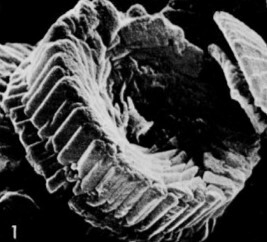Bomolithus cantabriae
Set number: 2323
-
1
-
2
-
3
-
4
-
5
-
6
-
7
-
8
-
9
-
10
-
11
-
12
-
13
-
14
-
15
-
16
-
17
-
18
-
19
-
20
10µm
Heliolithus? cantabriae Perch-Nielsen, 1971a
Large (8.0–15.0μm) species of Bomolithus comprised of two discs, a moderate-high column, and a canal containing a plug. The discs are of unequal diameter (e.g. diameter of proximal disc >diameter of the median disc) and appear relatively flat or slightly convex/concave (clearly seen in the side-view). The moderate-high column is wide (e.g. width>height) and parallel-sided and possesses a distinct canal closed by a central plug. The diameter of the column is slightly less than the diameter of the median disc.
In plan view, the column is finely segmented and appears in various shades of yellow. The central plug appears smooth with unresolved segments (the plug is usually removed/not preserved due to adverse paleoenvironmental conditions). The fine segments comprising the discs are moderately broad and appear as shades of white in plan view. In the distal view, the extinction lines are dextrogyre, whereas the extinction lines are laevogyre in the proximal view. When viewed using a gypsum plate, the horizontal axis of the coccolith lies within the blue sector on the distal/column-side. Still, the vertical axis of the coccolith lies within the blue sector on the proximal/disc side. The discs, column, and plug appear birefringent in both plan view and side view.
The overall size of the species is variable, ranging from moderately large to very large forms. The diameter of the median disc is typically slightly greater than the diameter of the column. The median disc appears wedge-shaped in the side view. Bomolithus cantabriae possesses a proximal disc that is wider than the median disc, which is a distinguishing characteristic used to separate the species from Bomolithus elegans and Bomolithus dydimolofous. Moreover, Bomolithus cantabriae has a cylindrical column with a cone-like distal depression, whereas Bomolithus dydimolofous has a low dome-shaped column. Bomolithus universus appears butterfly-like in the side-view, differing from Bomolithus cantabriae by having a distally flaring column with a maximum diameter equal to the diameter of the proximal disc. Bomolithus cantabriae is generally larger than Bomolithus elegans and has double discs of unequal diameter. The number of segments comprising Bomolithus cantabriae (about 40–60) is much greater than the number of segments comprising Bomolithus elegans (about 24–32). The double discs are in equal in diameter in Bomolithus elegans.
Bowman, A. R. & Varol, O. 2021. A Taxonomic Revision of Heliolithaceae - Applications in Resolving the Problematic Calcareous Nannofossil Biostratigraphy of the Paleocene. In: M. Montenary, M. (Ed.). Calcareous nannofossil biostratigraphy of the Stratigraphy and timescales. 6: 43-223.
Perch-Nielsen, K. 1971a. Durchsicht Tertiarer Coccolithen. In, Farinacci, A. (ed.) Proceedings of the Second Planktonic Conference Roma 1970. Edizioni Tecnoscienza, Rome. 2: 939-980
Roth, P. H. 1973. Calcareous nannofossils: Leg 17 of the Deep Sea Drilling Project. Initial Reports of the Deep Sea Drilling Project. 17: 695-795.
